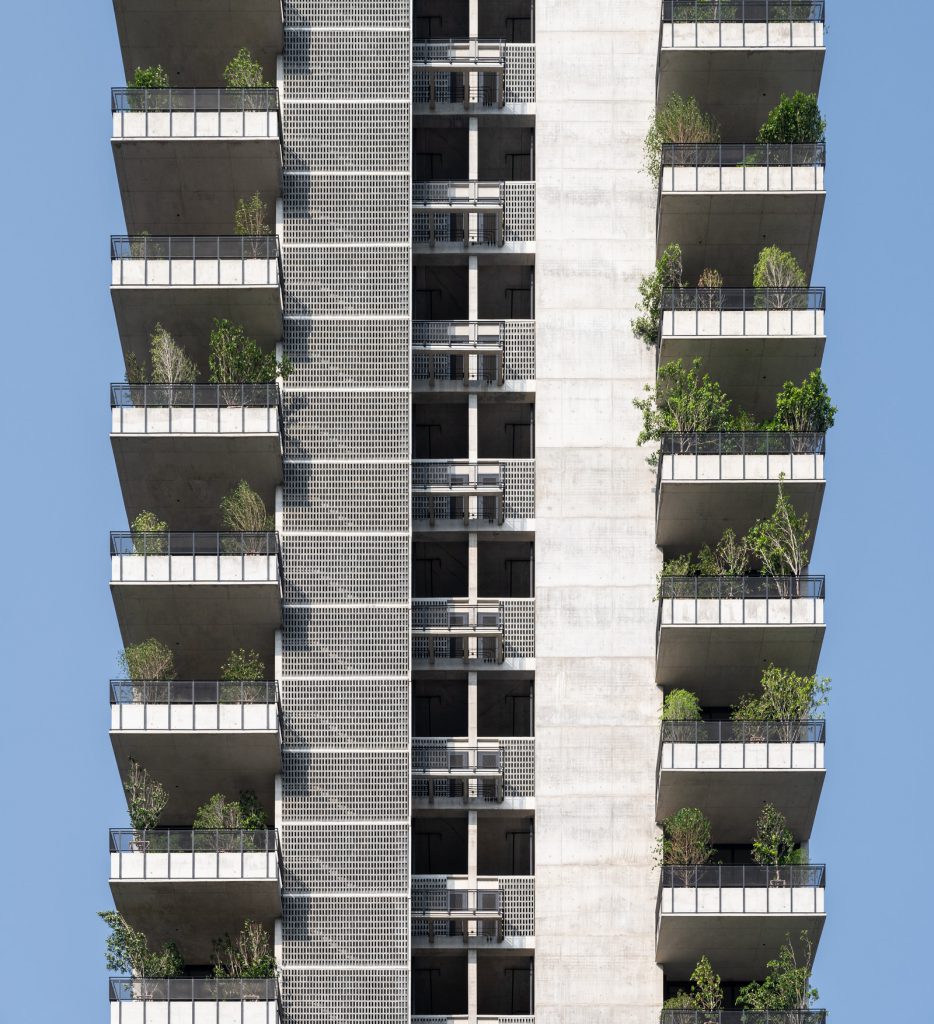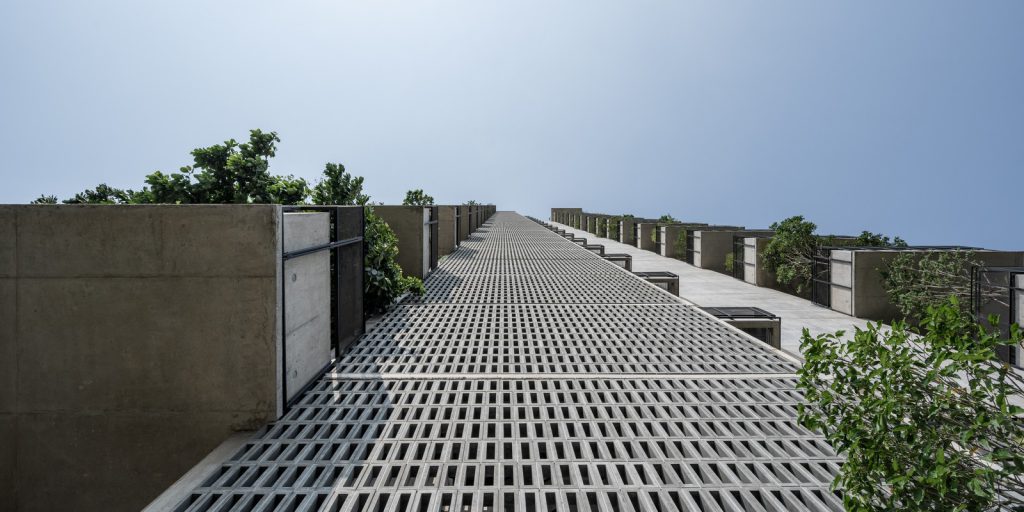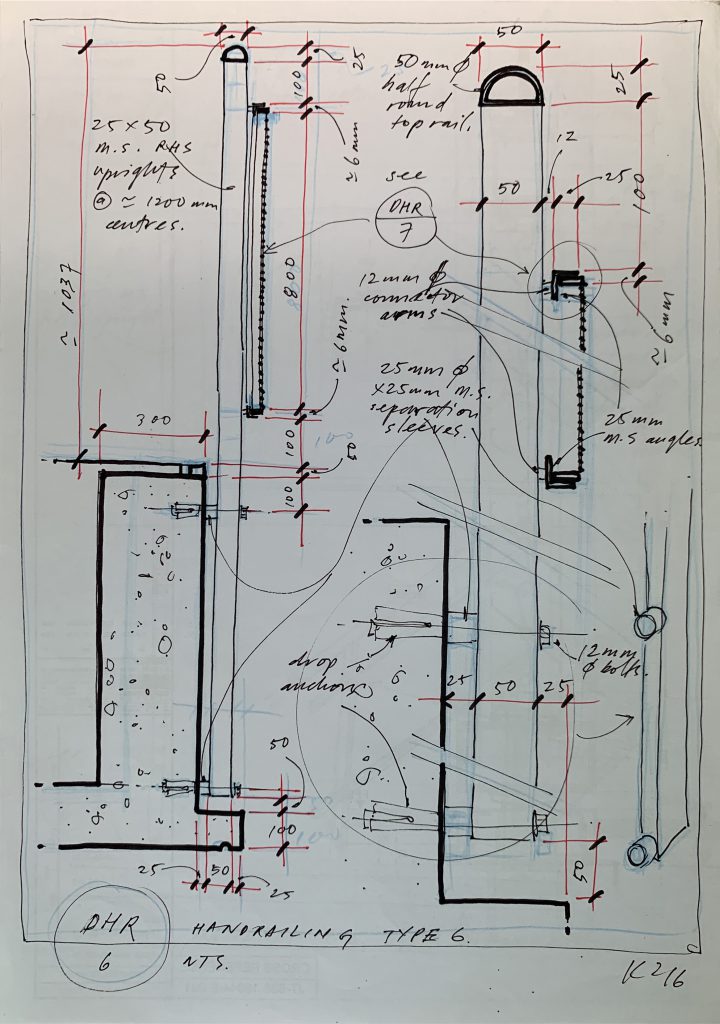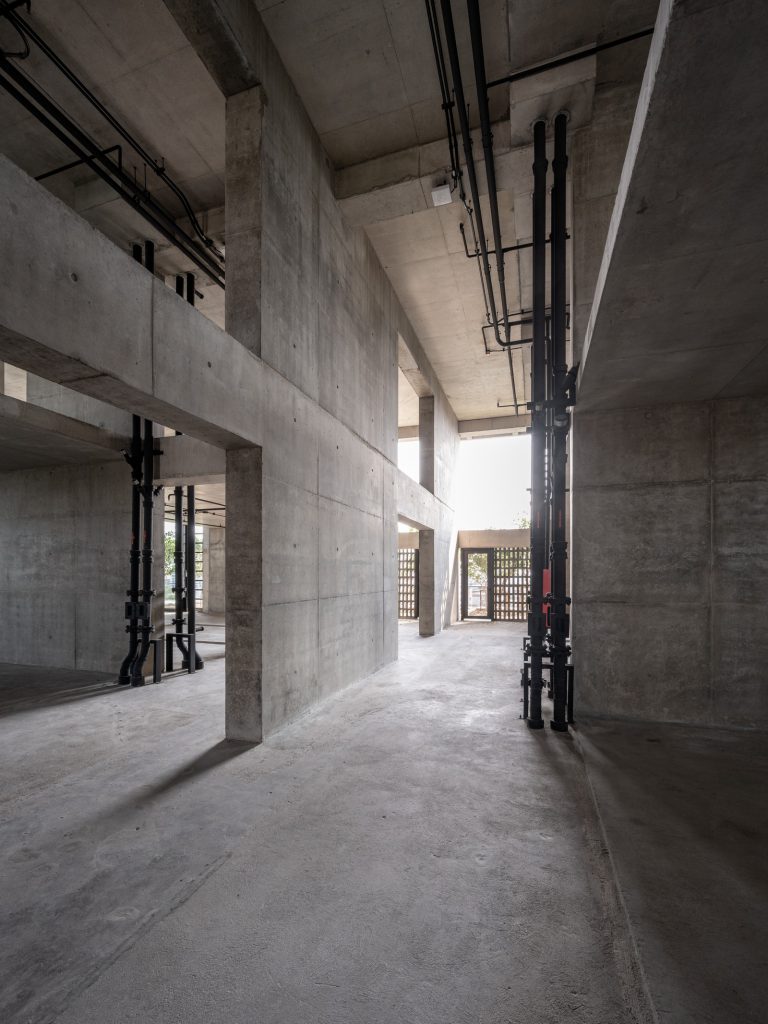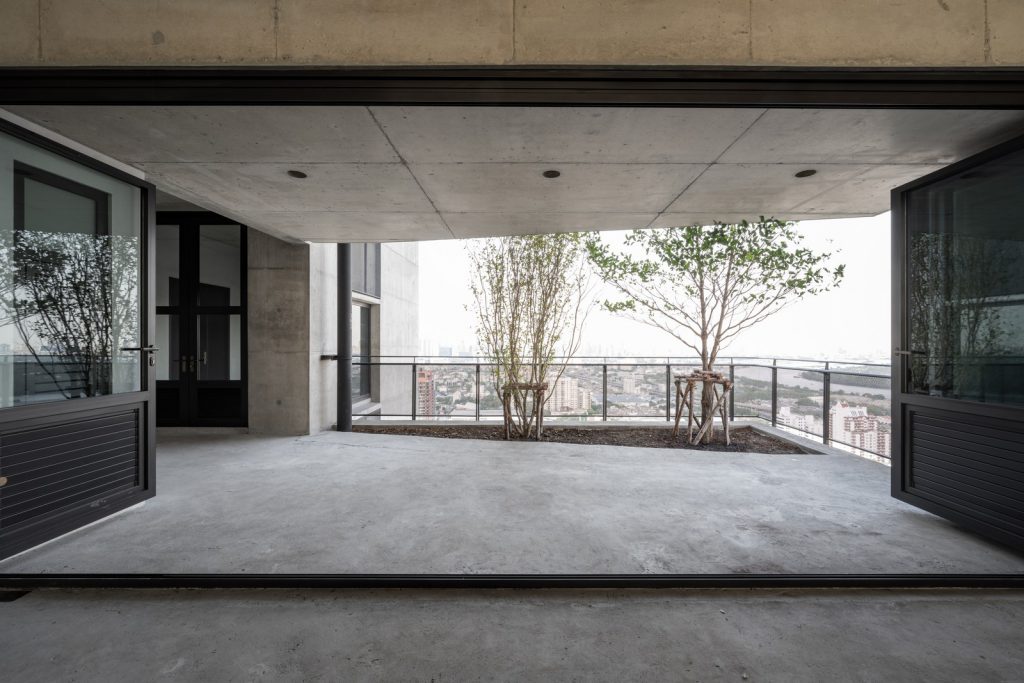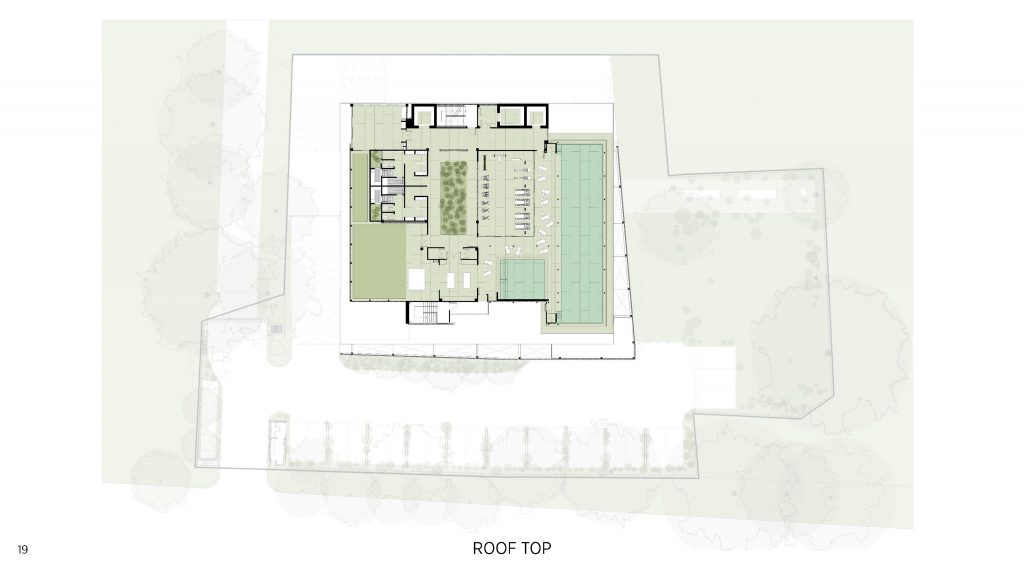The best houes is one that can vemtilate efficiently and thoroughly explained Kevin Mark Low about what makes a home a smart home in the design for this 28-storey luxurious condominium on Naradhiwas Road.
Text: Sasikan Srisopon
Photo Courtesy of YPL Co., Ltd. and SkyGround architectural film & photography except as noted
Download the online journal Issue 05 Home Smart Home Click here

ความเป็น Smart home อาจเข้าใจได้มากกว่าการประยุกต์ใช้เทคโนโลยีเชื่อมต่อกับระบบและอุปกรณ์ต่าง ๆ ภายในบ้านเพื่อตอบสนองความต้องการและอำนวยความสะดวกให้กับผู้อยู่อาศัยในด้านต่าง ๆ ซึ่ง Windshell Naradhiwas ได้สะท้อนตัวตน Smart home ผ่านรูปแบบอาคารทางตั้งที่มีความแตกต่างจากโครงการอื่น ๆ เริ่มจากแนวคิดของคุณโชติพล เตชะไกรศรี กรรมการผู้จัดการบริษัท วาย แอล พี จำกัด ที่ต้องการมี “บ้าน” ในเมืองที่สะดวกต่อการเดินทาง มีพื้นที่ใช้สอยขนาดใหญ่ ใกล้ชิดกับธรรมชาติ และมีสิ่งอำนวยความสะดวกครบครันแบบคอนโดมิเนียม ถูกนำมาตีความและสร้างสรรค์เป็นโครงการ Luxury คอนโดมิเนียมสูง 28 ชั้น 36 ยูนิต บนที่ดินประมาณ 2 ไร่ ย่านใจกลางเมืองติดถนนนราธิวาสราชนครินทร์ เขตยานนาวา โดยมี Kevin Mark Low สถาปนิกชาวมาเลเซีย เป็นผู้ดูแลด้านการออกแบบร่วมกับบริษัท เอซีเอส ดีไซน์ สตูดิโอ จำกัด ในงานออกแบบโครงการ
“บ้านที่ดีที่สุดจะมีความสามารถในการระบายอากาศข้ามผ่านได้ดีและทั่วถึง” เป็นมุมมองสำคัญหนึ่งที่ Kevin Mark Low ได้อธิบายถึงคุณลักษณะที่ดีของบ้านไว้ แต่คุณลักษณะดังกล่าวแทบไม่ปรากฏให้เห็นในที่อยู่อาศัยทางตั้งในประเทศไทยเนื่องด้วยข้อกำหนดต่าง ๆ ในการก่อสร้างและความคุ้มค่าในการลงทุน เราจึงมักเห็นการแก้ปัญหาโดยการใช้ระบบเครื่องปรับอากาศเกือบทุกพื้นที่ในคอนโดมิเนียมและอาคารสูงรูปทรงกล่องห่อหุ้มด้วยกระจก อย่างไรก็ตาม Windshell Naradhiwas ได้ทลายข้อจำกัดเหล่านั้น ด้วยความมุ่งมั่นของสถาปนิกที่ต้องการเปลี่ยนแปลงสิ่งต่าง ๆ โดยไม่ทำสิ่งที่เหมือนใคร จากความคิดเริ่มต้นที่ว่า “จะไม่อนุญาตให้เครื่องปรับอากาศเข้ามาออกแบบอาคาร แต่จะออกแบบอาคารให้เราสามารถถอดเครื่องปรับอากาศออกได้”
จากมุมมองดังกล่าวจึงเป็นที่มาของ “Tropical Stacking Home” แนวคิดสำคัญในการออกแบบอาคารหลังนี้ ด้วยการออกแบบให้ “บ้าน” มีพื้นที่ใช้สอยขนาดใหญ่และมีสวนหน้าบ้าน-หลังบ้าน วางซ้อนกันเป็นทางตั้ง และมีลมทะลุผ่านทั่วถึงทุกพื้นที่ภายในพื้นที่พักอาศัยเสมือนเราอยู่บ้านเดี่ยวบนพื้นดิน เนื่องจากสภาพแวดล้อมรอบข้างที่ตั้งโครงการส่วนใหญ่เป็นชุมชนแนวราบสถาปนิกจึงออกแบบอาคารให้หันหน้ารับทิศทางลมธรรมชาติตามแนวทิศตะวันออกเฉียงเหนือ-ตะวันตกเฉียงใต้ได้ตลอดทั้งปี นอกจากนั้นยังออกแบบช่องทางให้ลมสามารถเข้าและออกได้ตามหลัก Natural Cross Ventilation และจัดวางพื้นที่ให้เกิดการระบายอากาศที่อาศัยความแตกต่างของอุณหภูมิที่เรียกว่า Stack Ventilation โดยการวางช่องระบายอากาศอยู่ทั่วถึงในส่วนบนของอาคาร ทำให้มวลอากาศร้อนสามารถลอยตัวขึ้นที่สูงและระบายออก ดูดกระแสมวลอากาศเย็นจากภายนอกไหลเข้ามาแทนที่เกิดการไหลเวียนของอากาศโดยอัตโนมัติทั้งอาคาร การออกแบบดังกล่าวนับเป็นจุดเด่นของอาคารที่แก้ปัญหาเรื่องการระบายอากาศในอาคารสูงและช่วยสร้างสภาวะน่าสบายให้กับพื้นที่อยู่อาศัยตามธรรมชาติได้อย่างดีสำหรับอาคารพักอาศัยทางตั้งในเมือง
สำหรับการออกแบบผังพื้นที่ใช้สอยนั้น นับว่าเป็นความน่าสนใจทั้งในการสร้างจุดขายของโครงการในระดับราคาเดียวกันและเสนอแนวทางการออกแบบพื้นที่พักอาศัยประเภทอาคารสูงในเมือง จากปกติที่มักมีข้อจำกัดในการปรับเปลี่ยนพื้นที่ใช้งานต่าง ๆ ให้ตอบรับลักษณะการใช้ชีวิตของเจ้าของยูนิตแต่ละคน ด้วยเงื่อนไขของการก่อสร้าง โครงสร้างและงานระบบต่าง ๆ แต่ Kevin Mark Low และทางโครงการได้เสนอการออกแบบด้วยวิธีการที่แม้จะดูตรงไปตรงมาแต่ต้องอาศัยการวางแผนไว้เป็นอย่างดี ด้วยการออกแบบยูนิตห้องเปล่าที่ขายแบบ Bare Shell และเตรียมเพียงส่วนงานระบบไว้รองรับ ผังพื้นจึงมีความยืดหยุ่น เปิดโอกาสให้ผู้อยู่อาศัยออกแบบตกแต่งและกั้นพื้นที่ได้เองในหลายจุด ตั้งแต่การวางผังทุกชั้นให้มีเพียง 2 ยูนิต คือขนาด 453 ตารางเมตรและขนาด 562 ตารางเมตร แต่สามารถต่อรวมเป็นพื้นที่เดียวกันได้หากต้องการ จนถึงการกั้นพื้นที่ห้องต่าง ๆ ที่เหมาะกับรูปแบบวิถีชีวิตของแต่ละคน โดยแต่ละยูนิตจะมีลิฟต์และโถงลิฟต์ส่วนตัวที่สร้างความรู้สึกปลอดภัยและความรู้สึกเป็นส่วนตัวสูงให้กับผู้อยู่อาศัย
สถาปนิกยังแบ่งผังห้องพักเป็นพื้นที่ 3 ส่วนหลัก คือ หน้าบ้าน (Front Garden) ตัวบ้าน (House) และหลังบ้าน (Back Garden) ซึ่งพื้นที่ทั้ง 3 ส่วนสามารถรองรับการใช้งานได้อย่างต่อเนื่อง ในขณะเดียวกันก็สร้างความเป็นพื้นที่ส่วนกลาง และพื้นที่ส่วนตัวได้ชัดเจนตอบรับกับความต้องการผู้ใช้ โดยบริเวณหน้าบ้าน (Front Garden) ออกแบบให้เป็นพื้นที่เฉลียงขนาดใหญ่สามารถมองเห็นทัศนียภาพภายนอกอาคารได้ในมุมกว้าง และมีสวนหน้าบ้านที่มีพื้นที่รองรับการใช้งานลึกประมาณ 1 เมตร ทำให้สามารถปลูกต้นไม้ขนาดกลางที่มีความสูงได้ถึง 4-5 เมตรหรือทำบ่อน้ำขนาดเล็กได้ ช่วยสร้างความรู้สึกใกล้ชิดธรรมชาติเสมือนอยู่บ้านบนพื้นดิน
ในส่วนของตัวบ้าน (House) มีโถงกลางขนาดใหญ่เป็นศูนย์กลางของผัง เป็นพื้นที่เปิดโล่งแบบฝ้าเพดานสูง (Double space) หรือ Duplex ที่มีความสูงถึง 7 เมตร ต่อเนื่องกับพื้นที่ชั้นล่างที่สามารถกั้นสัดส่วนเป็นห้องย่อยรองรับกิจกรรมอื่น ๆ ได้อย่างอิสระ และเชื่อมกับพื้นที่ชั้น 2 ที่สามารถจัดเป็นพื้นที่ห้องนอนแบบมีห้องน้ำในตัวได้ถึง 2-3 ห้องและพื้นที่สำหรับพักผ่อนอเนกประสงค์ ซึ่งผู้อยู่อาศัยสามารถออกแบบพื้นที่ใช้งานรวมถึงกำหนดรูปแบบบันไดได้เองตามความต้องการ นอกจากนี้บริเวณโถงกลางยังสามารถมองเห็นพื้นที่ระเบียงและสวนด้านหลังผ่านประตูกระจกขนาดใหญ่สูง 5.5 เมตรที่สามารถเปิดรับแสงและให้ลมธรรมชาติสามารถผ่านเข้ามาได้โดยไม่จำเป็นต้องใช้เครื่องปรับอากาศตลอดเวลา ด้วยโครงสร้างอาคารนี้ใช้ Shear Wall หรือระบบผนังคอนกรีตเสริมเหล็กที่หล่อขึ้นมาได้อย่างประณีตทำหน้าที่รับน้ำหนักแทนคานและเสา จึงเอื้อให้พื้นที่ภายในห้องไม่มีโครงสร้างอาคารมาเป็นอุปสรรคในการปรับเปลี่ยนพื้นที่ใช้งานหรือบดบังมุมมอง ทำให้ผู้อยู่อาศัยสามารถออกแบบพื้นที่ต่าง ๆ ได้อย่างหลากหลาย
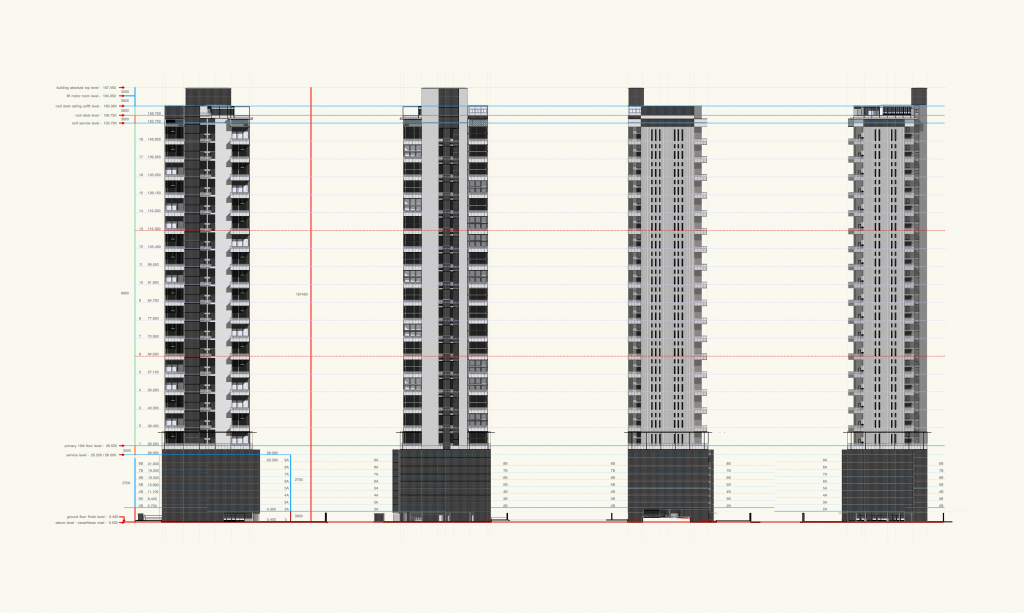
ผู้ออกแบบได้จัดเตรียมพื้นที่ให้สามารถทำได้ทั้งครัวเปิดและครัวปิด ต่อเนื่องกับพื้นที่หลังบ้าน (Back Garden) ที่มีขนาดกว้างรองรับการใช้งานได้อย่างสะดวก และมีพื้นที่เก็บของชิ้นใหญ่ช่วยสร้างความเรียบร้อยให้กับพื้นที่ นอกจากนี้พื้นที่ส่วนหลังบ้านยังออกแบบไว้ให้มีช่องเปิดขนาดใหญ่ที่ทำหน้าที่เป็นช่องลมของอาคารทั้งหลัง ซึ่งลมสามารถพัดผ่านและระบายอากาศได้ตลอดเวลาทำให้เกิดการไหลเวียนของอากาศที่ดี รูปลักษณ์อาคารภายนอกถูกออกแบบให้มีความเรียบง่ายไม่ปรุงแต่งมาก แต่สร้างความโดดเด่นและมีเอกลักษณ์เฉพาะตัวด้วยผิวอาคารที่เปิดเผยให้เนื้อแท้ของวัสดุที่ใช้ทั้งภายในและภายนอกอาคารอันประกอบด้วย คอนกรีต ไม้ และเหล็ก ซึ่งรูปแบบดังกล่าวอาจไม่ได้แสดงความเรียบหรูของอาคารตามที่เราเคยพบ แต่เป็นการแสดงความงามแบบดิบ ๆ สะท้อนถึงความเป็นสัจจะของวัสดุที่ยอมรับในความงามของวัสดุที่เปลี่ยนแปลงไปตามกาลเวลา ดังนั้นการออกแบบดังกล่าวจึงอาจดึงดูดความสนใจได้ในคนบางกลุ่ม นอกจากนั้นสถาปนิกยังตั้งใจเผยให้เห็นงานระบบท่ออาคารต่าง ๆ ทั้งหมดที่ติดตั้งไว้อย่างเป็นระเบียบเรียบร้อย เพื่อความสะดวกต่อการจัดการดูแลรักษารวมถึงง่ายต่อการตรวจสอบเมื่อเกิดกรณีชำรุดเสียหาย ซึ่งการโชว์งานระบบในอาคารเช่นนี้ต้องคัดเลือกวัสดุอุปกรณ์ในการติดตั้งที่เหมาะสมกับรูปแบบของสถาปัตยกรรมและอาศัยฝีมือช่างในการก่อสร้างที่พิถีพิถันและได้คุณภาพ เพื่อให้สามารถใช้งานได้อย่างมีประสิทธิภาพรวมทั้งสร้างความสวยงามในขณะเดียวกัน
เมื่อเข้าใจถึงพฤติกรรมและความต้องการของผู้อยู่อาศัย ปัญหาและข้อจำกัดของการอยู่อาศัยในอาคารสูง ผนวกกับการให้ความสำคัญเรื่องสิ่งแวดล้อม รวมถึงมุ่งเลือกใช้เทคโนโลยีให้เกิดประโยชน์อย่างคุ้มค่า ทำให้ Windshell Naradhiwas เป็นคอนโดมิเนียมที่สร้างประสบการณ์ใหม่ของการอยู่อาศัยแนวตั้งในเมือง สะท้อนความเป็น Smart Home ที่ไม่ได้แสดงถึงรูปลักษณ์อาคารหรืออาศัยเทคโนโลยีล้ำสมัย หากแต่แสดงให้เห็นผ่านการออกแบบอาคารอย่างชาญฉลาดของสถาปนิกกับการวางแผนไว้ล่วงหน้าส่วนหนึ่งและเปิดพื้นที่อิสระให้ผู้อยู่อาศัยสามารถออกแบบสะท้อนไลฟ์สไตล์และรสนิยมการใช้ชีวิตในบ้านของตนเองได้เต็มที่ โดยสถาปนิกเองต้องคาดการณ์ล่วงหน้าและออกแบบสถาปัตยกรรมไว้รองรับฉากทัศน์ต่าง ๆ เหล่านั้นอย่างมีประสิทธิภาพ

The definition of a ‘smart home’ can be understood in much broader and diversified aspects than merely an application of technologies, home automation systems or advanced tools designed to fulfill the needs and bring home dwellers greater convenience in every possible dimension of one’s living experience. Windshell Naradhiwas reflects what a smart home can be through a vertical architectural structure that sets itself apart from other projects within the same price range.
Everything begins from Chotiphol Techakraisri, the Director of YLP Company Limited, and his idea of wanting to have a ‘house’ in the city with commuting convenience, big enough living space that is closer to nature and fully equipped facilities akin to a high-end condominium unit. The idea has been interpreted into the 28-story, 36-unit luxurious condominium, situated on a 0.8 acre land, right in the city center on Naradhiwas Rajanagarindra Road, in Bangkok’s Yannawa district with Kevin Mark Low, a Malaysian architect, together with ACS Design Studio Company Limited helming the architectural design of the project.
“The best house is one that has the ability to ventilate efficiently and thoroughly.” That’s one of the key qualities Kevin Mark Low explained about what makes a home a smart home. But such a feature is rarely found in most condominium projects in Thailand due to rules and regulations that come with the construction and the question of whether such effort would be worth the investment. Therefore, we have seen residential projects of this nature take an easy route of using air conditioning systems with almost every functional space while the architecture is always the high-rise boxy shape wrapped in a glass shell. Nevertheless, Windshell Naradhiwas resorts to dismantling those limitations with the architect’s determination to bring changes without following the norm. The initial conceptualized idea is ‘to prohibit the air conditioning system from dictating the design of the building, and design the building with removable air conditioners instead.’
With that being the starting point, the ’Tropical Stacking Home’ concept was born and treated as the key element of the architectural design, leading to the design of an urban home inside a high-rise residential building with sizeable functional spaces, and a garden at both the front and the back. The project’s vertically overlapped living units have natural wind flowing through all the living spaces, just like something one can expect from horizontal living spaces of a single-detached home. With the project being surrounded by a neighborhood of low-rise residential homes, the architect designs the building to take in natural wind flowing from the northeast-southwest direction all year round. This stack ventilation involves the placement of openings at the upper part of the building, enabling the hot air to float upward and be ventilated, while pulling in the cool air from the outside to replace the ventilated heat, creating an automatic natural ventilation for the entire building. This quality becomes the building’s key features that helps solve the ventilation issues found in most high-rise buildings while also naturally bringing thermal comfort to the residents living in urbanized vertical residential buildings.
The design of the layout is interesting for both its ability to be the selling point of the project, especially when compared to other condominiums within the same price range, as well as how it has proposed a new approach to residential spaces in urban high-rise condominiums. Normally, a project of this nature often comes with some sorts of limitation of how functional spaces can be adjusted to accommodate the lifestyle of each owner of each living unit since there are conditions regarding the construction of structural and system works. Kevin Mark Low and the project’s owner, however, chose a seemingly straightforward approach that required thoughtful and careful planning. The bare shell units are designed to have all the necessary system works, leaving the floor plan highly flexible for prospective residents to design and partition several parts of the unit as desired. Every floor of the condominium houses only two units (435 and 563 square meters), which can also be connected into one unit upon the owner’s wish. The room partitioning can be done to suit each resident’s lifestyle and behaviors, while each unit has a private elevator lobby for the residents’ greater sense of safety and privacy.
The architect also divides each unit into three main sections; front garden, house and back garden. These three portions of space offer uninterrupted spatial continuity but each with clear functionalities as both public and private spaces, which are what the targeted users need. The front garden is designed as a large patio that opens to a wide view of the city. The floor is designed and built with one meter depth, allowing homeowners to grow mid-sized trees with maximum 4-5 meter height or a small pool to bring nature closer to their everyday life.
The ‘house’ section is home to a large double space or duplex space with an impressive 7 meter ceiling height. The area is linked to the lower floor, which can be partitioned into rooms to freely accommodate different activities, and the second floor that can house 2-3 bedrooms with ensuite bathrooms, including a multifunctional living space. The inhabitants can design common spaces and the staircase according to their wishes. The main living area looks out to the balcony and the front garden through the massive, 5.5-meter high glass doors that can effectively allow sunlight and natural cross ventilation, keeping the living space from being air conditioned all the time. With the building’s structure constructed using shear walls or a reinforced concrete walling system, meticulously cast to bear the weight of the architectural and structural mass, each unit is absent of beams and columns, which would have otherwise obstructed the flexibility of the floor plan and the openness of the space. The inhabitants are given the freedom to design their own living spaces without having to worry too much about structural and spatial restrictions.

The architect works out the floor plan to house both an open or closed kitchen. The Back Garden section of the floor plan is connected to the kitchen and super spacious in size for the utmost functional convenience with a storage space prepared to store large items to keep the living space tidy and organized. The Back Garden also houses a large opening, which functions as the building’s natural ventilator, effectively facilitating uninterrupted airflow. The building’s exterior is materialized to embrace simplicity with unrefined but aesthetically distinctive and unique beauty that reveals real textural attributes of materials such as concrete, wood and steel. The approach the architect takes with the project’s architectural style may not be an expression of conventional luxury most people are familiar with. But within such raw beauty lies the ‘truth to material’ that accepts and celebrates the transformative beauty of materials through time. It’s understandable that the design may appeal to merely a certain group of individuals. The architect deliberately reveals system and pipe works immaculately installed for maintenance convenience and inspection should any damage occur in the future. Leaving system works exposed requires a careful selection of fittings for the installation to be done appropriately and suitable for the building’s architectural style. The process relies greatly on the skills and experiences of builders, for the functional and decorative components to fully deliver efficient functionality and aesthetic merits at the same time.
With the users’ behaviors and needs, potential problems and limitations of high-rise living experiences, as well as environmental issues are studied and understood, and met with maximized benefits of technologies, Windshell Naradhiwas becomes a condominium project that brings new experiences to urban vertical living. The project reflects a definition of smart home, not just through the building’s aesthetic appearance or highly advanced technologies it has, but the architect’s approach to architectural design, with a carefully thought out plan and masterful execution. For the design to leave the space for inhabitants and offer them the freedom to curate their own living spaces that reflect their own lifestyles and tastes, attentive speculation on the architect’s part had to be made in advance for the design of the architecture that will efficiently and satisfyingly accommodate future possible scenarios in prospective users’ living experiences.



